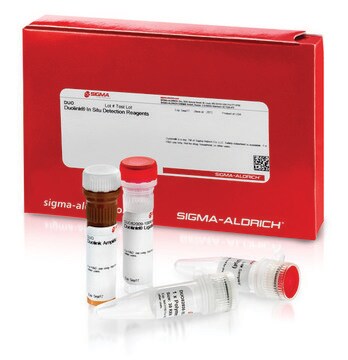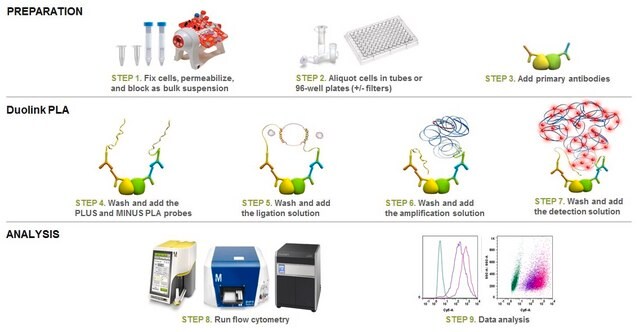DUO92103
Duolink® In Situ Red Starter Kit Mouse/Goat
Synonym(e):
in situ Proximity Ligation Assay Kit, Protein Protein Interaction Kit
About This Item
Empfohlene Produkte
Produktlinie
Duolink®
Methode(n)
proximity ligation assay: suitable
Fluoreszenz
λex 594 nm; λem 624 nm (red) (Texas Red®; Zeiss Filter set 31)
Eignung
suitable for fluorescence
Lagertemp.
−20°C
Anwendung
Follow the Duolink® In Situ Fluorescence Protocol to use this product. A set of short instructionsis also available.
Visit our Duolink® PLA Resource Center for information on how to run a Duolink® experiment, applications, troubleshooting, and more.
To perform a complete Duolink® PLA in situ experiment you will need two primary antibodies (PLA, IHC, ICC or IF validated) that recognize two target epitopes. This starter kit supplies all other necessary reagents for 30 Duolink® PLA reactions, which include a pair of PLA probes (Anti-Mouse PLUS and Anti-Goat MINUS), red detection reagents, wash buffers, and mounting medium.Note that the primary antibodies must come from the same species as the Duolink® PLA probes. Analysis is carried out using standard immunofluorescence assay equipment.
The Duolink® In Situ Red Starter Kit Mouse/Goat requires one primary antibody from mouse and one primary antibody from goat. Red fluorescence detection reagents are often used with Texas Red® filter.
Application Note
Two primary antibodies raised in different species are needed. Test your primary antibodies (IgG-class, mono- or polyclonal) in a standard immunofluorescence (IF), immunohistochemistry (IHC) or immunocytochemistry (ICC) assay to determine the optimal fixation, blocking, and titer conditions. Duolink®PLA in situ reagents are suitable for use on fixed cells, cytospin cells, cells grown on slide, formalin-fixed, paraffin embedded (FFPE), or tissue (fresh or frozen). No minimum number of cells is required.
Let us do the work for you, learn more about our Custom Service Program to accelerate your Duolink® projects
View full Duolink® product list
Leistungsmerkmale und Vorteile
- No overexpression or genetic manipulation required
- High specificity (fewer false positives)
- Single molecule sensitivity due to rolling circle amplification
- Relative quantification possible
- No special equipment needed
- Quicker and simpler than FRET
- Increased accuracy compared to co-IP
- Publication-ready results
Rechtliche Hinweise
Kit-Komponenten auch einzeln erhältlich
- DUO92006Duolink® In Situ PLA® Probe Anti-Goat MINUS, Affinity purified Donkey anti-Goat IgG (H+L)SDB
- DUO92001Duolink® In Situ PLA® Probe Anti-Mouse PLUSSDB
- DUO92008Duolink® In Situ Detection Reagents RedSDB
- DUO82049Duolink® In Situ Wash Buffers, FluorescenceSDB
- DUO82040Duolink® In Situ Mounting Medium with DAPISDB
Signalwort
Danger
H-Sätze
Gefahreneinstufungen
Aquatic Chronic 2 - Met. Corr. 1 - Resp. Sens. 1 - Skin Sens. 1
Lagerklassenschlüssel
8A - Combustible corrosive hazardous materials
Flammpunkt (°F)
Not applicable
Flammpunkt (°C)
Not applicable
Zulassungslistungen
Zulassungslistungen werden hauptsächlich für chemische Produkte erstellt. Für nicht-chemische Produkte können hier nur begrenzte Angaben gemacht werden. Kein Eintrag bedeutet, dass keine der Komponenten gelistet ist. Es liegt in der Verantwortung des Benutzers, die sichere und legale Verwendung des Produkts zu gewährleisten.
EU REACH Annex XIV (Authorisation List)
Analysenzertifikate (COA)
Suchen Sie nach Analysenzertifikate (COA), indem Sie die Lot-/Chargennummer des Produkts eingeben. Lot- und Chargennummern sind auf dem Produktetikett hinter den Wörtern ‘Lot’ oder ‘Batch’ (Lot oder Charge) zu finden.
Besitzen Sie dieses Produkt bereits?
In der Dokumentenbibliothek finden Sie die Dokumentation zu den Produkten, die Sie kürzlich erworben haben.
Kunden haben sich ebenfalls angesehen
Artikel
Duolink® proximity ligation assay used to study neuron interactions furthering neuroscience research.
Protocol for immunofluorescent detection of proteins in cells and tissue
Find Duolink references based on the type of method used, post translational modification detected, and research focus.
Things to consider for preparation, setup and execution of the Duolink® assay protocol
Protokolle
This page details the Duolink® In Situ Short Protocol for fluorescence detection
Verwandter Inhalt
Applications to detect, quantify and visualize protein-protein interactions, post-translational modifications and low expression protein detection using proximity ligation assay
Unser Team von Wissenschaftlern verfügt über Erfahrung in allen Forschungsbereichen einschließlich Life Science, Materialwissenschaften, chemischer Synthese, Chromatographie, Analytik und vielen mehr..
Setzen Sie sich mit dem technischen Dienst in Verbindung.










